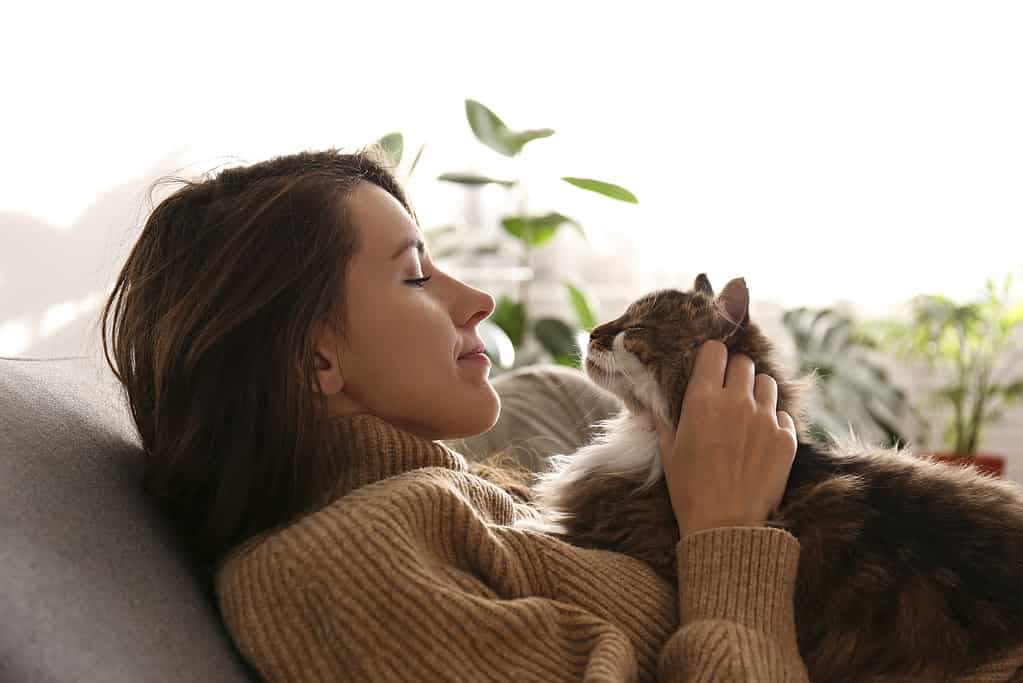Despite their reputation as aloof creatures, cats have 276 different facial expressions. A newly published study took a deep dive into the emotional lives of cats and found when interacting with each other, cats use a multitude of facial expressions to communicate.
Cats Have 276 Different Facial Expressions

Research has revealed cats can make nearly 300 different facial expressions.
©Azovsky/Shutterstock.com
The study, published in the journal Behavioural Processes, reported recording a total of 276 distinct facial expressions. The cats in the study included a colony of about 50 domesticated cats that lived in the CatCafé Lounge in Los Angeles, a non-profit rescue organization.
The cat café features an open floor plan where house cats roam while visitors can stop by and meet the various cats available for adoption. In nice weather, the café includes a fenced-in outdoor area. All of the research was conducted by filming cats interacting in the open spaces within the café. Researchers Lauren Scott (University of Kansas Medical Center) and Brittany Florkiewicz (Department of Psychology, Lyon College) spent one year hanging out in the café and recording video footage of the interactions between the cats. After collecting 194 minutes containing 186 interactions, Scott and Florkiewicz analyzed the various cat expressions.
The felines’ expressions fell into three main categories:
- Friendly (45%)
- Aggressive (37%)
- Ambiguous or falling into both categories (18%)
The different expressions were made up of a combination of 26 facial movements. Some of these were very subtle, including shifts in ear position, whisker movement, nose licks, blinks, and mouth movements.
How Many Facial Expressions Do Other Animals Have?

Chimpanzees can make 357 distinct facial expressions.
©Patrick Rolands/Shutterstock.com
Comparatively, research on chimpanzees has revealed 357 different facial expressions. While we know that humans have 44 unique facial movements, research hasn’t determined how many different expressions can come out of those facial movements. We also know dogs also have 27 facial movements. But again, we don’t know how many distinct facial expressions can be combined from these facial movements.
How Do Cats Communicate With Other Cats?
Cats have varying ways to communicate with each other. Aside from facial expressions, they have other ways to get their point across. Cats mainly communicate with each other through vocalizations, physical contact, visual (eye contact, facial movements, body posture), and chemical cues (pheromones.)

Although kittens meow at their mothers, adult cats do not communicate with each other by meowing.
©Elena Kurkutova/iStock via Getty Images
Interestingly, animal experts have discovered adult cats don’t meow at each other. Kittens will meow to get attention from their mothers, but once they grow older, they don’t meow at other cats. Meowing is exclusively used for communicating with humans.
How to Read a Cat’s Body Language
Cats will let you know how they’re feeling through their body language. Friendly and confident cats hold their tails high in the air with ears turned forward and a tall body. When cats feel safe with other cats, they may roll over and expose their stomachs, revealing the most vulnerable part of their body. The study also revealed what they called a common play face among cats. This is when the cat drops their jaw and draws back the corners of their mouth. Monkeys, dogs, and people share this common play expression.

Flat ears and a high level of alertness signal a cat is frightened.
©Clare Louise Jackson/Shutterstock.com
However, when cats are afraid, they may look away, not make eye contact, lick their lips, or flatten their ears. Rather than standing tall, like a happy and confident cat, a frightened cat may crouch close to the ground. When fear turns to aggression, cats may hiss, growl, arch their backs, flatten their ears, and lash their tails from side to side.
How Do Cats Communicate With Humans?

Cats have learned many ways to show affection to the humans they live with.
©Evrymmnt/iStock via Getty Images
Cats have learned to communicate with humans in a variety of ways. Aside from body language, cats have also learned to imitate humans as another means of communication. Cats may mimic their owner’s personality, such as copying extroversion or introversion. Cats also use facial expressions and eye contact to communicate with their owners.
Further, as discussed above, cats use their meows to communicate their wants and needs to their owners. According to the ASPCA, a cat’s meow could mean some of the following things:
- To ask for food
- As a greeting
- For attention
- To ask to be petted
- To be let in or out
Implications of the New Research
Cats have learned other ways to communicate with humans that we are more receptive to. But when communicating with each other, they use hundreds of different facial expressions to get their point across.
The implication for cat owners is that we could learn a lot about what our cats are trying to tell us by paying closer attention to the movement in their faces. Florkiewicz told Earth.com, “These findings show it is good to look at a cat’s ears, eyes, and whiskers to understand if they are feeling friendly.”
The photo featured at the top of this post is © I Wei Huang/Shutterstock.com
Thank you for reading! Have some feedback for us? Contact the AZ Animals editorial team.







